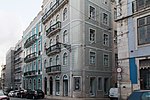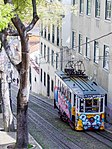Statue of António Vieira
2017 establishments in PortugalBuildings and structures completed in 2017Monuments and memorials in LisbonUse British English from June 2020

A statue of António Vieira stands in Trindade Coelho Square in the civil parish of Misericórdia in Lisbon, in front of the Church of Saint Roch and the headquarters of the Lisbon Holy House of Mercy. António Vieira (1608–1697) was a noted Jesuit preacher and missionary in Colonial Brazil. It was unveiled in 2017.
Excerpt from the Wikipedia article Statue of António Vieira (License: CC BY-SA 3.0, Authors, Images).Statue of António Vieira
Largo Trindade Coelho, Lisbon Misericórdia (Misericórdia)
Geographical coordinates (GPS) Address Website Nearby Places Show on map
Geographical coordinates (GPS)
| Latitude | Longitude |
|---|---|
| N 38.7133 ° | E -9.1431 ° |
Address
Padre António Vieira
Largo Trindade Coelho
1200-470 Lisbon, Misericórdia (Misericórdia)
Portugal
Open on Google Maps








